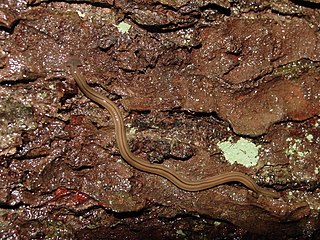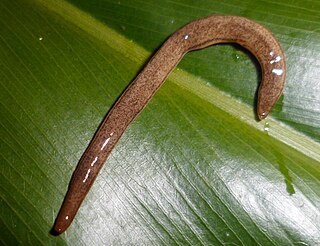
The New Zealand flatworm is a large land flatworm native to New Zealand. It can vary from 5 mm in length when hatched to approximately 17 centimetres (6.7 in) in mature adults.

Geoplanidae is a family of flatworms known commonly as land planarians or land flatworms.

Bipalium is a genus of large predatory land planarians. They are often loosely called "hammerhead worms" or "broadhead planarians" because of the distinctive shape of their head region. Land planarians are unique in that they possess a "creeping sole", a highly ciliated region on the ventral epidermis that helps them to creep over the substrate. Several species are considered invasive to the United States, Canada, and Europe. Some studies have begun the investigation of the evolutionary ecology of these invasive planarians.

The elephant trunk snake or the Javan file snake, is a species of snake in the family Acrochordidae, a family which represents a group of primitive non-venomous aquatic snakes.

Bipalium kewense, also known as the shovel-headed garden worm, is a species of large predatory land planarian with a cosmopolitan distribution. It is sometimes referred to as a "hammerhead flatworm" due to its half-moon-shaped head, but this name is also used to refer to other species in the subfamily Bipaliinae.

Bipalium adventitium, the wandering broadhead planarian, is a land planarian in the subfamily Bipaliinae. It has been accidentally introduced in the United States, where it is considered invasive.

Bipaliinae is a subfamily of land planarians found mainly in Madagascar, the Indian subcontinent and Southeast Asia, although some species have been introduced worldwide.
Geoplana is a genus of land planarians from South America.

Diversibipalium multilineatum is a species of large predatory land flatworm.

Endeavouria is a monotypic genus of land planarians from the Pacific region. It contains a single species, Endeavouria septemlineata.

Obama ficki is a large species of Brazilian land planarian in the subfamily Geoplaninae.

Supramontana irritata is a species of Brazilian land planarian in the subfamily Geoplaninae. It is the type species of the genus Supramontana.
Timyma is a genus of land planarians from Chile. It is the sole genus of the subfamily Timyminae.

Cratera viridimaculata is a species of land planarian found in Argentina.

Bipalium vagum, the wandering hammerhead worm, is a land planarian in the subfamily Bipaliinae. It has been accidentally introduced in the United States, Bermuda and various islands in the Caribbean and was recorded for the first time in Europe, in Italy, in 2021.

Bipalium nobile is a land planarian of the subfamily Bipaliinae found in Japan.

Humbertium covidum is a species of predatory land flatworm, found in France and Italy. The Holotype specimen is MNHN JL351B.
Othelosoma conyum is a species of land planarians in the family Microplaninae. It is found in the Democratic Republic of the Congo.
Othelosoma hepaticarum, the toffee flatworm, is a species of land planarian in the family Microplaninae endemic to South Africa.
Othelosoma joburgi, the sickgreen flatworm, is a species of land planarian belonging to the subfamily Microplaninae. It is native to South Africa.














